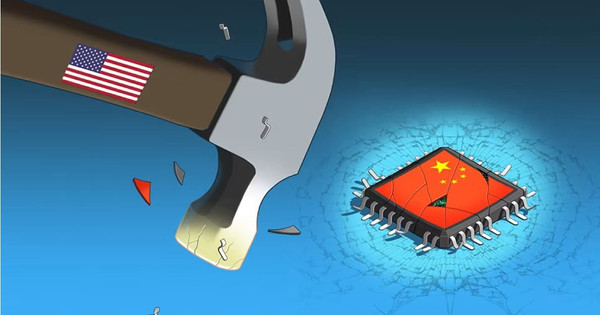China is equipped with “weapons”, pulling two technology giants to deal with sanctions from the US
- Tram Ho
Beijing grants training to deal with US sanctions
China recently formed a group including the Chinese Academy of Sciences, mobilizing tech giants such as Alibaba and Tencent to participate in the semiconductor chip design process, as Beijing prepares to face challenges. faces further sanctions from the US aimed at limiting China’s development of computer power.
Beijing thereby wants to reduce its reliance on Arm, which is owned by SoftBank and owns the technology that underpins much of the world’s semiconductors.
The team is currently using Risc-V – an open source chip design created in 2010 by the University of California, Berkeley.
Beijing’s interest in Risc-V has increased after Washington increased pressure on China’s technology sector by restricting access to chip products and advanced machinery.

The US has lobbied allies, including the Netherlands and Japan, to remove Chinese technology companies from their supply chains. This has led China to prepare for possible disruptions to the semiconductor manufacturing supply chain.
Arm, is headquartered in the UK but has a significant presence in the US. Arm is also considered vulnerable to any Washington sanctions against Beijing, as it supplies its designs to Chinese tech companies.
A Chinese official said the government-initiated effort to pool resources for Risc-V-based chip design would put China on the “right track”.
“At a time when the US is tightening export controls, we need to prepare for the worst,” the official added. The government-backed group – known as the Beijing Open Source Chip Research Institute – has developed “Xiangshan”, a high-performance Risc-V computer processor chip to match Arm’s models and promote development of the Chinese chip design market.
In China, the impetus for the use of Risc-V is increasingly urgent. “You don’t know when the US will launch the next round of sanctions. . . Using Arm’s architecture now is too risky, it’s like exposing your biggest weakness to the enemy,” said a Tencent engineer working on the Xiangshan project.
Competitive enough?
Before Beijing pushed to combine resources, Chinese tech giants Alibaba and ByteDance formed teams to use the Risc-V architecture to develop high-performance chips for data centers and data centers. AI algorithm.
“Our goal is to develop the Risc-V [chip] to replace the Arm chips that are currently in our most advanced products,” said a senior engineer at T-head, the chip manufacturing arm. of Alibaba said.
However, one executive said this goal is still many years away from becoming a reality as T-head faces limited capital due to declining profits at the parent company. ByteDance says its work is in its preliminary stages, while Alibaba sees its growth potential mainly in the area of Internet of Things.
Risc-V has been in the West’s attention since 2020, when a proposed $66 billion sale of Arm to US chipmaker Nvidia rocked the semiconductor industry, and spurred several companies to start began to consider more seriously alternatives to Arm. The deal then fell apart and SoftBank, which owns the chip designer, is now planning to list Arm on the New York Stock Exchange next year.
Earlier this year, US chipmaking giant Intel invested part of a $1 billion innovation fund in Risc-V, and said that its foundries would be able to make chips based on three main chip design architectures: Arm, X86, and Intel’s own Risc-V.
Rene Haas, Arm’s chief executive officer, acknowledged that the Risc-V was a “real threat to our business” in an interview earlier this year.
However, he said Arm has a significant advantage because it offers software alongside its designs, as well as having a community of 50 million developers, which sets it apart from Arm.” increasingly difficult”.
Semico Research forecasts that 62.4 billion Risc-V-based chips will be shipped by 2024. Semico estimates that Risc-V accounts for only $80 million worth of the total $2.2 billion market share. intellectual property rights for computer processor cores by 2020. However, they expect this to grow to $687 million by 2027 – increasing its global market share from 1% to 16%.
Richard Wawrzyniak, an analyst at Semico Research, said: “The Risc-V was initially just a novelty next to the Arm, then it became an alternative and now it is a competitor. “.
T-head, Xiangshan, and ByteDance are all developing Risc-V chips. To date, Risc-V has been mainly used to perform relatively simple tasks and in lesser-known components, or so-called “embedded” processes, as well as for IoT applications. .
But it has also recently begun to gain traction in some markets for chips that enhance device performance or enable “intelligence,” including central server processors. data and artificial intelligence chips.
Ron Black, chief executive officer of Codasip, said his company raised capital to design high-end processors because “many customers said we needed an alternative to Arm”.
Intel says the Risc-V “has traction in embedded markets and is expected to enter the IoT, automotive, mobile, and data center markets in the next three to five years.” The US chipmaker added that the open source architecture “is still in its infancy and needs ecosystem support to further innovate and drive widespread adoption in the market”.
However, some of Arm’s biggest customers are still not fully convinced of the potential of the Risc-V. Cristiano Amon, Qualcomm’s chief executive officer, said that the company had begun work on Risc-V designs for its low-power embedded microprocessors as a “defensive move”, but said Open architecture is still not complex enough to use for high performance features.
Source : Genk
